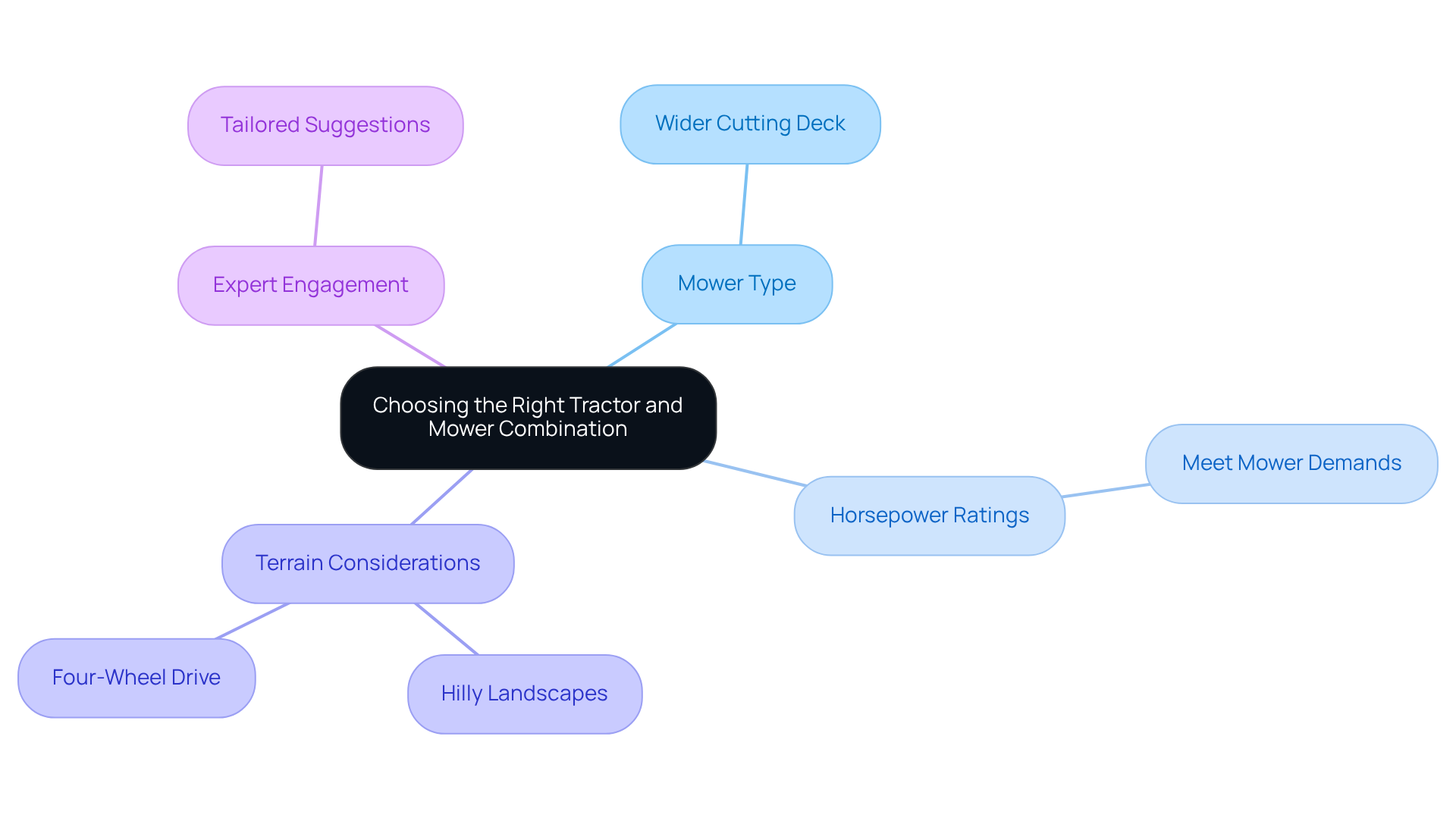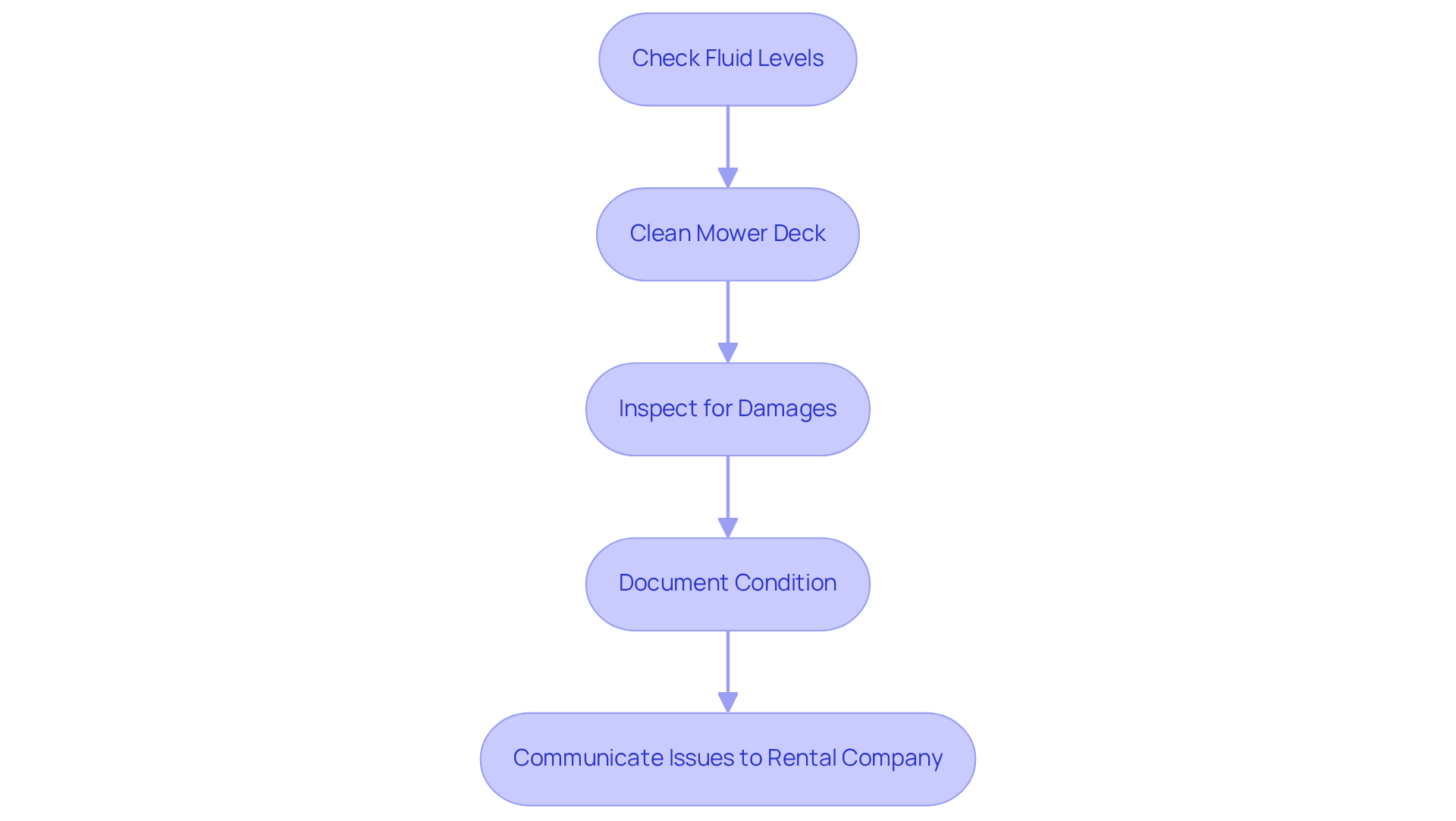Overview
Successful tractor with mower rental involves four essential steps:
- Evaluating project needs
- Selecting the right equipment
- Navigating the rental process
- Properly maintaining and returning the equipment
First, it is crucial to assess your requirements to ensure that the equipment meets the specific demands of your project. Next, choosing efficient combinations of equipment can significantly enhance productivity and performance. Understanding lease agreements is also vital, as it helps avoid potential pitfalls during the rental process. Finally, performing regular upkeep is necessary to maintain the equipment's functionality, ensuring a smooth rental experience. By following these steps, you can maximize your rental experience and achieve your project goals.
Key Highlights:
- Evaluate project scope by assessing area size, terrain type, and specific tasks for the tractor with mower rental.
- Document requirements such as lease length, deck size, and horsepower to guide the rental process.
- Choose tractor and mower combinations based on efficiency needs, considering cutting deck width and horsepower ratings.
- Engage leasing experts for tailored suggestions to maximise equipment efficiency based on documented needs.
- Familiarise yourself with the rental process, including completing applications, providing identification, and reviewing lease agreements.
- Pay attention to lease duration, expenses, maintenance responsibilities, and damage liability clauses.
- Perform regular upkeep on the rented equipment, including checking fluid levels and cleaning the mower deck.
- Inspect equipment for damages before returning it and document its condition to avoid disputes.
- Communicate any issues to the rental company to foster a reliable relationship and ensure a smoother rental experience.
Introduction
Navigating the world of tractor and mower rentals can be a daunting task, particularly for those unfamiliar with the intricacies of equipment leasing. It is essential to understand the specific needs of a project, as the right combination of tractor and mower can significantly impact efficiency and results. With numerous options available, how can one ensure they make the best choice? This guide outlines essential steps for achieving rental success. It offers insights into:
- Evaluating requirements
- Selecting the ideal equipment
- Maintaining professionalism throughout the rental process
Understand Your Rental Needs and Requirements
Begin by evaluating the scope of your project. Assess the size of the area you must mow, the type of terrain, and any specific tasks you want the tractor with mower rental to accomplish. For example, if you're mowing a large, flat field, a different tractor may be required compared to a hilly or uneven landscape. Furthermore, consider the length of the lease and any particular attributes you may require for your tractor with mower rental, such as deck size or horsepower. Document these requirements to guide your rental process effectively.

Choose the Right Tractor and Mower Combination
Explore the optimal combinations of farming vehicles, such as tractor with mower rental, and cutting equipment tailored to your project needs. If your goal is to efficiently cut grass across expansive areas, consider using a tractor with mower rental that features a wider cutting deck. It's crucial to examine the horsepower ratings to confirm that the vehicle can meet the demands of the mower. Furthermore, take the terrain into account; a tractor with mower rental and four-wheel drive may be essential for navigating hilly landscapes. Engage with leasing experts who can provide tailored suggestions based on your documented requirements, ensuring you select a combination that maximizes efficiency.

Navigate the Rental Process and Agreement
Once you've selected your equipment, it’s essential to familiarize yourself with the borrowing process. This typically involves:
- Completing a lease application
- Providing identification
- Possibly proof of insurance
Carefully review the lease agreement, paying close attention to:
- The duration
- Expenses
- Any additional charges
Look for clauses that outline maintenance responsibilities and damage liability. If anything is unclear, do not hesitate to reach out to the leasing company for clarification. This proactive approach is crucial in preventing potential issues down the line.

Maintain and Return the Equipment Properly
During the leasing period, it is essential to perform basic upkeep on the equipment. This includes:
- Regularly checking fluid levels
- Cleaning the mower deck after each use
Prior to returning the equipment, conduct a thorough inspection to identify any damages or issues that may have arisen during use. This diligence not only ensures the equipment's longevity but also protects you from potential disputes.
Cleaning the equipment before returning it is crucial to avoid additional cleaning fees. Make sure that all components are returned in good condition. Document the equipment's condition upon return, noting any discrepancies, and communicate any issues to the rental company. This proactive approach will help prevent misunderstandings regarding damages and foster a reliable relationship with the rental provider.
By adhering to these maintenance practices, you not only ensure the equipment remains in optimal condition but also enhance your experience with the rental company. This attention to detail reflects professionalism and respect for the equipment, ultimately leading to a smoother rental process and potential future engagements.

Conclusion
Understanding the intricacies of renting a tractor with a mower is essential for achieving successful outcomes in any mowing project. By carefully assessing rental needs, selecting the right equipment, navigating the rental process, and maintaining the machinery, individuals can ensure a smooth and efficient experience. Each step contributes to maximizing productivity and minimizing potential issues during the rental period.
Key points discussed include:
- The importance of evaluating project requirements, such as terrain and equipment specifications, to make informed decisions.
- Choosing the appropriate tractor and mower combination tailored to specific tasks can significantly enhance mowing efficiency.
- Familiarizing oneself with the rental agreement and maintaining the equipment during the lease period are crucial for avoiding misunderstandings and ensuring the equipment's longevity.
Ultimately, these practices not only enhance the immediate rental experience but also build a foundation for reliable relationships with rental providers. By following these guidelines, individuals can approach tractor with mower rentals with confidence. This approach ensures that they achieve their project goals while maintaining professionalism and respect for the equipment. Taking the time to implement these steps will lead to greater success and satisfaction in future equipment rental endeavors.
Frequently Asked Questions
How should I start when considering a tractor with mower rental?
Begin by evaluating the scope of your project, including the size of the area to be mowed, the type of terrain, and any specific tasks you want the tractor to accomplish.
Why is it important to assess the terrain before renting a tractor with a mower?
The type of terrain, such as whether it is flat, hilly, or uneven, will determine the kind of tractor needed for effective mowing.
What factors should I consider regarding the rental duration?
Consider the length of the lease to ensure it aligns with your project timeline and needs.
What specific attributes should I look for in a tractor with mower rental?
Look for attributes such as deck size and horsepower that may be necessary for your specific mowing tasks.
How can I effectively document my rental requirements?
Document your requirements by listing the scope of your project, terrain type, lease duration, and specific tractor attributes needed to guide your rental process.




